

TacTIC pédagogiques. Enseignants francophones utilisant l'approche de la classe inversée dans leurs cours - Google Sheets. 2 exemples d'utilisation de la classe inversée en science. Ce n’est pas la première fois que j’écris sur la classe inversée dans ce blogue.

Seven Ways to Increase Student Engagement in the Classroom. You have probably heard that teachers are the hardest people to teach.
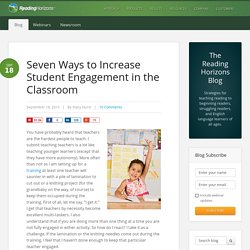
I submit teaching teachers is a lot like teaching younger learners (except that they have more autonomy). More often than not as I am setting up for a training at least one teacher will saunter in with a pile of lamination to cut out or a knitting project (for the grandbaby on the way, of course) to keep them occupied during the training. First of all, let me say, “I get it.” I get that teachers by necessity become excellent multi-taskers. I also understand that if you are doing more than one thing at a time you are not fully engaged in either activity. Five Levels of Student Engagement It should not surprise anyone to know that one of the most consistent findings in educational research demonstrates that the more times students spend engaged during instruction, the more they learn (Gettinger & Ball, 2007).
Blended Learning: Resource Roundup.
Projet pédagogique sur Wikipédia. Dans le cas d’un travail lié à un projet pédagogique sur Wikipédia, les modifications d’articles ou nouveaux articles créés par les étudiants sont accessibles par l’ensemble des francophones de la planète.
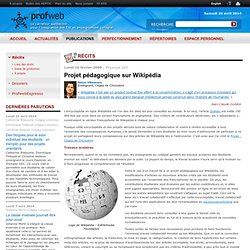
De plus, les contributions étudiantes sont évaluées par les autres contributeurs et, si elles sont jugées appropriées, demeureront des années en ligne et serviront de base pour les autres wikipédiens qui voudront s’attaquer au sujet traité. Ceci est la base du « travail collaboratif » effectué par cette encyclopédie, travail collaboratif qui est l’une des applications les plus remarquables du socioconstructivisme que j’ai vues.
Les étudiants peuvent donc consulter à leur guise le travail créé et, éventuellement, le peaufiner au fur et à mesure qu’ils acquièrent de nouvelles connaissances. Profile: Prof. Chris Whittaker. [Figure 1: Sigmoid function] You want to turn your classroom into an active learning environment – one where students understand, construct and apply knowledge, analyze, evaluate and create, instead of an environment where they spend most of their time listening – but you’re apprehensive and unsure?
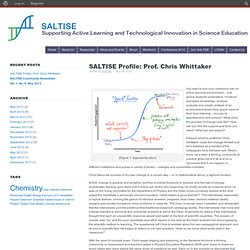
What does the process of change look like? Physicists are more intelligent than social scientists, paper says. Social scientists are of ‘lower average intelligence’ than those in natural sciences - at least at elite universities, authors argue Source: Getty Give us this day: wisdom to tell statistical significance from scientific significance If you have glimpsed social scientists alone in their offices with hands clasped in prayer, you might have assumed that they were fearing Armageddon for their discipline in an era of high tuition fees.
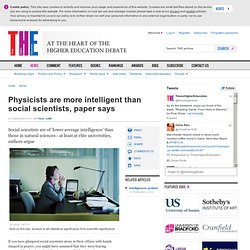
But, according to a new paper, the real explanation may be that social scientists are of “lower average intelligence” than their scientific colleagues – at least at elite universities. “Intelligence and religious and political differences among members of the US academic elite”, published in the Interdisciplinary Journal of Research on Religion, draws primarily on a 1967 study of 148 male academics at the University of Cambridge to demonstrate that the scientists at top institutions are more intelligent than the social scientists. paul.jump@tsleducation.com. VTE - Vitrine Technologie Education. Theme This joint laboratory of Vitrine technologie-éducation (VTÉ) and CFORP (Centre franco-ontarien de ressources pédagogiques) will begin Wednesday, September 25th 2013 (enrollment from Tuesday, September 3 on our website). VTÉ-CFORP's Lab Objectives This laboratory aims to discover serious game and its value as a teaching tool in higher education through experimentation.
Participants will actively explore some serious educational games available in Quebec. Furthermore, they will gain a complete overview of the full elaboration process then participants will experience an authoring tool in order to write a short play scenario they would incorporate into their course. A wide set of partners involved. Physica VF. Eye on IT: The 21st Century Classroom. Originally published by Raymond Cantin for Vitrine technologie-éducation on January 28, 2010.
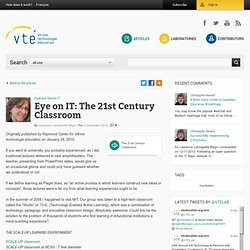
If you went to university, you probably experienced, as I did, traditional lectures delivered in vast amphitheaters. The teacher, presenting from PowerPoint slides, would give us an occasional glance and could only have guessed whether we understood or not. If we define learning as Piaget does, as “an active process in which learners construct new ideas or concepts”, those lectures were a far cry from what learning experiences ought to be. In the summer of 2008 I happened to visit MIT. Our group was taken to a high-tech classroom called the “Studio” or TEAL (Technology Enabled Active Learning), which was a combination of technology, pedagogy, and innovative classroom design.
Astrophysique. Vulgarisation scientifique. Électricité et magnétisme. Mécanique. Ondes et physique moderne. Khan Academy. Intégration des TIC. Éducation aux TIC. Home.